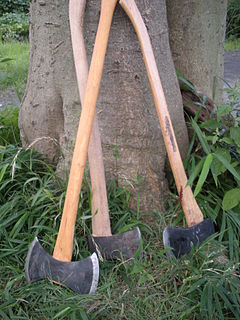 W
WAn axe is an implement that has been used for millennia to shape, split and cut wood, to harvest timber, as a weapon, and as a ceremonial or heraldic symbol. The axe has many forms and specialised uses but generally consists of an axe head with a handle, or helve.
 W
WAn alpenstock is a long wooden pole with an iron spike tip, used by shepherds for travel on snowfields and glaciers in the Alps since the Middle Ages. It is the antecedent of the modern ice axe.
 W
WThe Arkalochori Axe is a 2nd millennium BC Minoan bronze votive double axe (labrys) excavated by Spyridon Marinatos in 1934 in the Arkalochori cave on Crete, which is believed to have been used for religious rituals. It is inscribed with fifteen symbols.
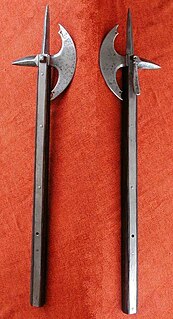 W
WA battle axe is an axe specifically designed for combat. Battle axes were specialized versions of utility axes. Many were suitable for use in one hand, while others were larger and were deployed two-handed.
 W
WA bearded axe, or Skeggøx refers to various axes, used as a tool and weapon, as early as the 6th century AD. It is most commonly associated with Viking Age Scandinavians. The hook or "beard", i. e. the lower portion of the axe bit extending the cutting edge below the width of the butt, provides a wide cutting surface while keeping the overall weight of the axe low.
 W
WA broadaxe is a large-(broad) headed axe. There are two categories of cutting edge on broadaxes, both are used for shaping logs by hewing. On one type, one side is flat and the other side beveled, a basilled edge, also called a side axe, single bevel, or chisle-edged axe. On the other type, both sides are beveled, sometimes called a double bevel axe, which produces a scalloped cut. On the basilled broadaxe the handle may curve away from the flat side to allow an optimal stance by the hewer in relation to the hewn surface. The flat blade is to make the flat surface but can only be worked from one direction and are right-handed or left-handed. The double bevel axe has a straight handle can be swung with either side against the wood. A double beveled broad axe can be used for chopping or notching and hewing. When used for hewing, a notch is chopped in the side of the log down to a marked line, called scoring. The pieces of wood between these notches are removed with an axe called joggling and then the remaining wood is chopped away to the line.
 W
WCarpenter's axes or Carpenter's hatchets are small axes, usually slightly larger than a hatchet, used in traditional woodwork, joinery and log-building. They have pronounced beards and finger notches to allow a "choked" grip for precise control.
 W
WA cleaving axe or cleaver is a form of axe used within green woodworking to split wood lengthways. Cleaving (riving) is used to turn a log into lumber or billets into firewood. Splitting axe is sometimes described as an old name for a splitting maul or froe.
 W
WThe dagger-axe is a type of pole weapon that was in use from the Erlitou culture until the Han dynasty in China. It consists of a dagger-shaped blade, mounted by its tang to a perpendicular wooden shaft. The earliest dagger-axe blades were made of stone. Later versions used bronze. Jade versions were also made for ceremonial use. There is a variant type with a divided two-part head, consisting of the usual straight blade and a scythe-like blade.
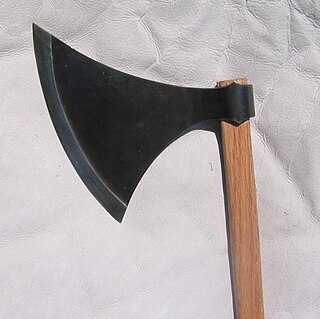 W
WThe Dane axe is an early type of battle axe, primarily used during the transition between the European Viking Age and early Middle Ages. Other names for the weapon include English long axe, Danish axe, and hafted axe.
 W
WThe doloire or wagoner's axe was a tool and weapon used during the Middle Ages and Renaissance. The axe had a wooden shaft measuring approximately 1.5 metres (5 feet) in length and a head that was pointed at the top and rounded at the bottom, resembling either a teardrop or an isosceles triangle. The top of the shaft was fitted with a metal eye or socket that was welded to the head of the axe near the base of the blade. The upper part of the blade extended above the eye, while the opposite side of the socket featured a small blunt hammer head. The head of the axe itself measured approximately 44 cm. (17 inches) in length, was sharpened on the back and flattened bottom edges, and was uniformly decorated with punched and incised abstract floral patterns.
 W
WA froe, shake axe or paling knife is a tool for cleaving wood by splitting it along the grain. It is an L-shaped tool, used by hammering one edge of its blade into the end of a piece of wood in the direction of the grain, then twisting the blade in the wood by rotating the haft (handle).
 W
WThe Gray's Inn Lane Hand Axe is a pointed flint hand axe, found buried in gravel under Gray's Inn Lane, London, England, by pioneering archaeologist John Conyers in 1679, and now in the British Museum. The hand axe is a fine example from about 350,000 years ago, in the Lower Paleolithic period, but its main significance lies in the role it and the circumstances of its excavation played in the emerging understanding of early human history.
 W
WHacking or side knives may be considered as either light hatchets or heavyweight knives.
 W
WA halberd is a two-handed pole weapon that came to prominent use during the 14th, 15th, and 16th centuries. The word halberd is most likely equivalent to the German word Hellebarde, deriving from Middle High German halm (handle) and barte (battleaxe) joined to form helmbarte. Troops that used the weapon were called halberdiers.
 W
WA hand axe is a prehistoric stone tool with two faces that is the longest-used tool in human history, it is also a fine example of core tool. It is usually made from flint or chert. It is characteristic of the lower Acheulean and middle Palaeolithic (Mousterian) periods. Its technical name (biface) comes from the fact that the archetypical model is generally bifacial Lithic flake and almond-shaped (amygdaloidal). Hand axes tend to be symmetrical along their longitudinal axis and formed by pressure or percussion. The most common hand axes have a pointed end and rounded base, which gives them their characteristic shape, and both faces have been knapped to remove the natural cortex, at least partially. Hand axes are a type of the somewhat wider biface group of two-faced tools or weapons.
 W
WA hatchet is a single-handed striking tool with a sharp blade on one side used to cut and split wood, and a hammerhead on the other side. Hatchets may also be used for hewing when making flattened surfaces on logs; when the hatchet head is optimized for this purpose it is called a hewing hatchet.
 W
WHelko, is a German manufacturer of axes and forestry tools, located in the town of Wuppertal and founded in 1844. Today, it is one of the largest axe manufacturers in Europe, and exports products to more than 40 countries.
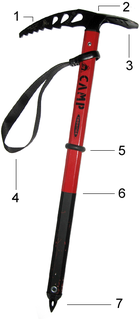 W
WAn ice axe is a multi-purpose hiking and climbing tool used by mountaineers in both the ascent and descent of routes that involve frozen conditions with snow or ice. An ice axe can be held and employed in a number of different ways, depending on the terrain encountered. In its simplest role, the ice axe is used like a walking stick in the uphill hand, the mountaineer holding the head in the center. It can also be buried pick down, the rope tied around the shaft to form a secure anchor on which to bring up a second climber, or buried vertically to form a stomp belay. The adze is used to cut footsteps, as well as scoop/bucket seats in the hillside and trenches to bury an ice axe belay. The long-handled alpenstock was a predecessor to the modern ice axe.
 W
WThe Indonesian ceremonial bronze axes were Bronze Age objects that were produced in the Indonesian archipelago between the 1st and 2nd century AD. Archaeological sites in Java, Bali, Sulawesi, the eastern islands, and around Lake Sentani in Papua have been uncovered, showing the bronze axes at the center of a bronze production or at burial sites. They are a testimony of the extensive trade network in the islands of the archipelago in the first millennium AD, thought to be connected to the Dong Son culture.
 W
WLabrys is, according to Plutarch, the Lydian word for the double-bitted axe.. The Ancient Greek plural of labrys is labryes.
 W
WThe Lochaber axe is a type of poleaxe that was used almost exclusively in Scotland. It was usually mounted on a staff about five feet long.
 W
WA mambele is a form of hybrid knife/axe in central and southern Africa, originating from a curved throwing dagger used by the Mangbetu.
 W
WMarking axe or marking hatchet is a small hatchet which is used by forest workers to mark trees designated for logging or for thinning. These axes were used also for trail blazing or for marking the ends of the felled logs for identification of the owner.
 W
WThe Nzappa zap is a traditional weapon from the Congo similar to an axe or hatchet.
 W
WOno (斧) or masakari is the Japanese word for "axe", and is used to describe various tools of similar structure. As with axes in other cultures, ono are sometimes employed as weapons. Many existing examples of this particular weapon are associated with the sōhei or yamabushi, who also adapt other agricultural tools as weapons, although samurai are also pictured as using ono in woodblock prints. Ono that were specifically designed for military use are of extreme rarity. The weapon version of the ono is described as having "a very large head with a very convex cutting edge and a large scroll-shaped peen opposite it. It has a sheath covering only the edge of the blade. The entire length is nearly six feet".
 W
WAn onzil is a throwing knife of ethnic groups from eastern Gabon.
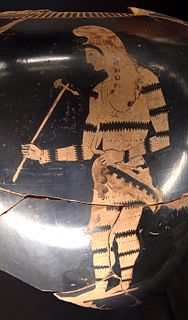 W
WThe sagaris is an ancient Iranian shafted weapon used by the horse-riding ancient Saka and Scythian peoples of the great Eurasian steppe. It was used also by Western and Central Asian peoples: the Medes, Persians, Parthians, Indo-Saka, Kushans, Mossynoeci, and others living within the milieu of Iranian peoples. According to Aristarchus of Samothrace, the legendary Amazons used the sagaris, as well. In The Histories, Herodotus attributes the sagaris to the Sacae Scythians in the army-list of Xerxes the Great.
 W
WThe shepherd's axe is a long thin light axe of Eurasian origin used in past centuries by shepherds in the Carpathian Mountains and in other territories which comprise today Slovakia, Czech Republic, Poland, Ukraine, Romania and Hungary. The features of a shepherd's axe combine a tool with a walking stick, that could be used as a light weapon. It has symbolic historical and cultural connotations and is still used as a prop in many traditional dances, for example the odzemek. Among its precursors is a Hungarian battle axe called fokos.
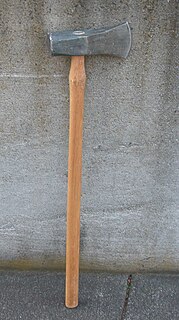 W
WA splitting maul also known as a block buster, block splitter, chop and maul, sledge axe, go-devil or hamaxe is a heavy, long-handled axe used for splitting a piece of wood along its grain. One side of its head is like a sledgehammer, and the other side is like an axe.
 W
WThe tlaximaltepoztli or simply tepoztli was a common weapon used by civilizations from Mesoamerica which was formed by a wooden haft in which the poll of the bronze head was inlaid in a hole in the haft. It was used for war or as a tool. Its use is documented by the Codex Mendoza and the Codex Fejérváry-Mayer. Tax collectors from the Aztec Empire demanded this kind of axe as tribute from the subjugated kingdoms. In Aztec mythology, the tepoztli was used by the god Tepoztécatl, god of fermentation and fertility. In Codex Borgia he is represented with a bronze axe.
 W
WA tomahawk is a type of single-handed axe native to the many Indigenous peoples and nations of North America, traditionally resembling a hatchet with a straight shaft. The term came into the English language in the 17th century as an adaptation of the Powhatan word.
 W
WA trumbash or trombash is a Mangbetu throwing knife from the Democratic Republic of Congo.
 W
WA twybil is a hand tool used for green woodworking. It is used for chopping out mortises when timber framing, or making smaller pieces such as gates. It combines chopping and levering functions in a single tool.
 W
WThe world's largest axe is located in Nackawic, New Brunswick, Canada.